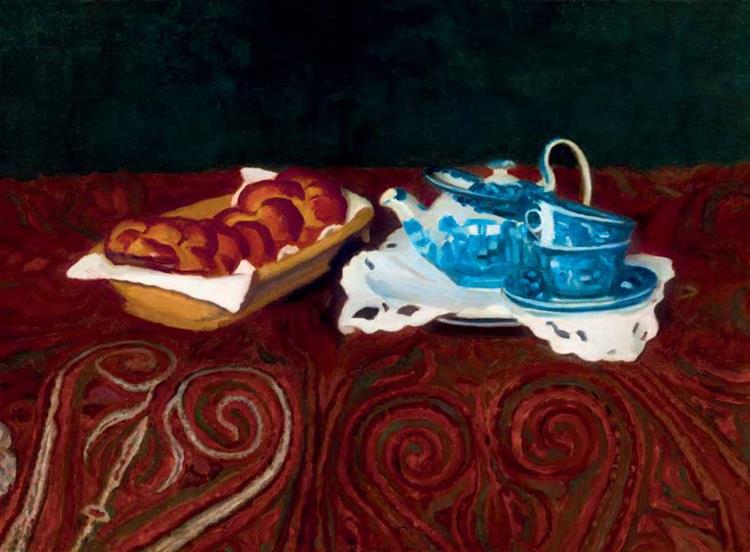Description
"Kalács this Kék Porcelán 1911" by Károly Ferenczy is a work that encapsulates the apogee of Hungarian impressionism in the dawn of the twentieth century. Ferenczy, a central figure at the Nagybánya school, stood out for his ability to capture moments of everyday life with a poetic and colorful touch. This painting, whose title is translated as "sweet bread and blue porcelain," is a brilliant example of its technical mastery and compositional talent.
Observing "Kalács this kek Porcelán 1911," the spectator is immediately caught by the serenity emanating from the canvas. A sweet bread, a Hungarian specialty also known as "Kalacs," is presented in the foreground, about what seems to be a simple table, accompanied by a delicate piece of blue porcelain. The choice of these objects is not accidental; Beyond their intrinsic beauty, they evoke a feeling of home and tradition, precious aspects in the Hungarian culture. The blue porcelain especially, typically decorated with intricate floral patterns, speaks of a deeply rooted cultural and artisan wealth.
The composition is simple but balanced, guiding the viewer's view from one object to another softly. Ferenczy demonstrates exceptional control of negative space, allowing the elements to breathe and stand out for themselves. The realism with which the details of the sweet bread and the porcelain have been reflected contrasts with the softness of the shadows and the natural light that bathes the scene, creating a visual dialogue between the real and the ethereal.
The colors in "Kalács Es Kék Porcelán 1911" are fundamental to discern the artist's intentions. The sensitive use of brown and golden tones of sweet bread suggests warmth and family closeness. In contrast, the cold blue of the porcelain offer a perfect counterweight, preventing warmth to become overwhelming and ensuring a harmonic balance. The color palette, although minimal, is perfectly orchestrated to evoke feelings of calm and satisfaction.
Ferenczy, throughout his career, showed a deep interest in light and how it defines and transforms its environment. In this work, the light seems to emanate from a natural source outside the canvas, possibly a window, illuminating the scene in a dim but clear way. This lighting not only gives life to the objects represented, but also creates an intimate and cozy atmosphere, typical of the impressionist style.
Although "Kalács este kek Porcelaán 1911" does not include human figures, the implicit presence of the human being is palpable. The portrayed objects are evocative to a narrative of domestic tranquility, of a preparation to share and enjoy a simple but precious food. Through this simple disposition of food and objects, Ferenczy manages to transmit a deep emotional connection with the viewer, reminding us of beauty in the ordinary moments of everyday life.
In summary, "Kalács Es Kék Porcelán 1911" not only represents an impressive technical skill and an acute eye for color and light by Károly Ferenczy, but also encapsulates a vibrant cultural and emotional history. The work is a testimony of how painting can raise the everyday to the sublime, inviting the viewer to find beauty and meaning in every corner of their own existence.
KUADROS ©, a famous paint on your wall.
Hand-made oil painting reproductions, with the quality of professional artists and the distinctive seal of KUADROS ©.
Art reproduction service with satisfaction guarantee. If you are not completely satisfied with the replica of your painting, we refund your money 100%.

